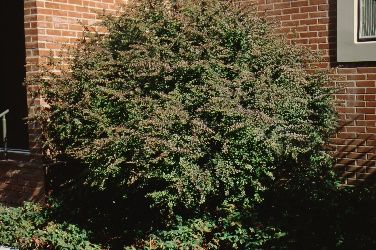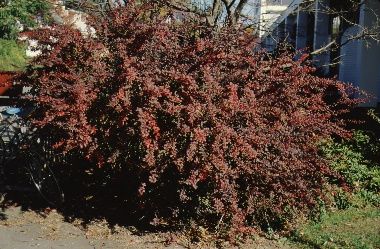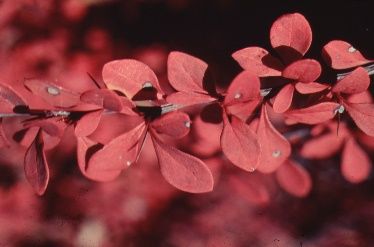Introduction
Japanese barberry is thorny, so it's useful for barrier plantings. The plant tolerates most light exposures and soils, but purple-leaved cultivars turn green in shade. This shrub grows slowly but transplants easily. It grows three to six feet tall and spreads four to seven feet. Japanese barberry can be sheared and used as a hedge plant. The main ornamental features are persistent red fruits and fall color in shades of red, orange and yellow. Some strains fruit more heavily than others. The plant produces yellow flowers, but these are not highly ornamental.

Credit: Edward F. Gilman, UF/IFAS

Credit: Edward F. Gilman, UF/IFAS

Credit: Edward F. Gilman, UF/IFAS

Credit: Edward F. Gilman, UF/IFAS
General Information
Scientific name: Berberis thunbergii
Pronunciation: BUR-bur-iss thun-BUR-jee-eye
Common name(s): Japanese barberry, crimson pygmy
Family: Berberidaceae
Plant type: ground cover; shrub
USDA hardiness zones: 4 through 9 (Figure 5)
Planting month for zone 7: year round
Planting month for zone 8: year round
Planting month for zone 9: year round
Origin: native to temperate Asia
Invasive potential: invasive and not recommended by UF/IFAS faculty (reassess in 10 years)
Uses: border; mass planting; ground cover; hedge; edging; small parking lot islands (< 100 square feet in size); medium sized parking lot islands (100-200 square feet in size); large parking lot islands (> 200 square feet in size)
Availability: generally available in many areas within its hardiness range

Credit: undefined
Description
Height: 2 to 8 feet
Spread: 4 to 6 feet
Plant habit: round
Plant density: dense
Growth rate: moderate
Texture: fine
Foliage
Leaf arrangement: alternate
Leaf type: simple
Leaf margin: terminal spine
Leaf shape: obovate
Leaf venation: pinnate
Leaf type and persistence: deciduous
Leaf blade length: less than 2 inches
Leaf color: purple or red
Fall color: yellow; orange
Fall characteristic: showy
Flower
Flower color: white
Flower characteristic: spring flowering
Fruit
Fruit shape: oval
Fruit length: less than .5 inch
Fruit cover: fleshy
Fruit color: red
Fruit characteristic: persists on the plant; attracts birds
Trunk and Branches
Trunk/bark/branches: not particularly showy; typically multi-trunked or clumping stems
Current year stem/twig color: reddish
Current year stem/twig thickness: thin
Culture
Light requirement: plant grows in part shade/part sun; plant grows in the shade
Soil tolerances: sand; clay; acidic; loam; alkaline
Drought tolerance: moderate
Soil salt tolerances: poor
Plant spacing: 36 to 60 inches
Other
Roots: usually not a problem
Winter interest: plant has winter interest due to unusual form, nice persistent fruits, showy winter trunk, or winter flowers
Outstanding plant: not particularly outstanding
Pest resistance: no serious pests are normally seen on the plant
Use and Management
Several cultivars are listed: 'Atropurpurea'—reddish foliage; 'Atropurpurea Erecta'—purple leaves, erect habit; 'Atropurpurea Redbird'—better foliage color, leaves larger, more compact habit; 'Aurea'—bright yellow leaves; 'Crimson Pygmy'—a dwarf two feet high and three feet across, with reddish foliage; 'Globe'—globe-shaped, broad; 'Minor'—smaller leaves, fruit and flowers, rounded habit; 'Rose Glow'—new growth pink with red spots; 'Thornless'—no thorns; 'Variegata'—leaves with spots of white, light gray, and yellow.
Pests and Diseases
Aphids suck plant juices, and heavy infestations coat the leaves with sticky honeydew. Large aphid populations cause the new growth to be distorted. Aphids can be dislodged by a high -pressure water spray from the garden hose.
Scale insects blend in well with the stems and may not be readily noticed. Infestations can be controlled with horticultural oil. The preferred method of control involves regular inspection for early detection of the infestation then spraying with oil.
Bacterial leaf spots are first small and dark green and appear water soaked. Later the spots turn purplish-brown. Leaf stalks and new growth may also be attacked. Infection of older twigs results in dieback. Prune out and destroy infected twigs. There are fungicides which may take care of the problem.
Anthracnose is sometimes listed as a leaf spot. Symptoms are round, brown spots with reddish margins on the upper leaf surface. Another fungus causes purple spots on the leaves. There are fungicides which may provide some control of these diseases.
Powdery mildews of different genera cause a white coating on the leaves. Plant in full sun in an area with good air circulation to help prevent mildew.
Verticillium wilt causes wilting and eventual death. Nothing can be done but to keep plants healthy by watering and fertilizing. Severely infected plants do not recover.